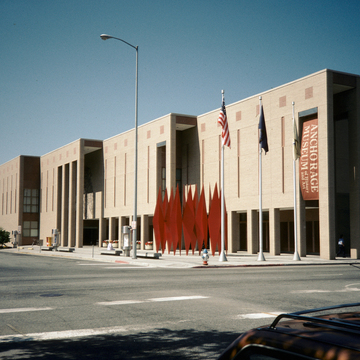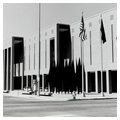Among the most significant cultural institutions in Alaska, the Anchorage Museum at Rasmuson Center opened in 1968 as the Anchorage Museum of History and Art. Since the late 1960s, the museum has more than tripled in size and undergone four distinct renovations and additions. Its collections have increasingly emphasized the art and culture of the Circumpolar North.
The original museum, constructed in 1966–1968, can be seen along Sixth Avenue. Designed by Kirk, Wallace and McKinley of Seattle in association with Schultz/Maynard of Anchorage, the virtually windowless building has blank brick walls ornamented with a broad frieze of derivative Native design, executed by sculptor Alex Duff Combs. The building was expanded to the west in 1973–1974, with Kenneth Maynard Associates replicating the original design. The museum then underwent another renovation when a two-story section was completed on its Seventh Avenue side in 1984–1986. In 2010, the Anchorage Museum opened its Smithsonian Arctic Studies Center, the Imaginarium Discovery Center, the Thomas Planetarium, and ConocoPhillips Gallery, all designed by David Chipperfield. And more recently, with financial support from Alaska philanthropist and financier Ed Rasmuson, in 2017 the Anchorage Museum opened the Rasmuson Wing, a 25,000-square-foot space dedicated to “Art of the North”; McCool Carlson Green of Anchorage served as architect, working with Davis Constructors. Along the Seventh Avenue front, the mass of the building is stepped back in four planes, which are pierced by two-story openings reminiscent of porticos and a one-story arcade. The buff brick wall is ornamented with brownstone trim in vertical lines and topped by a row of square medallions, a decorative effect borrowed by the Fifth Avenue Mall. Here, the facade is interesting but not busy. The more recent additions have emphasized custom insulated fritted glass and wood framing.
The museum features a warm oak interior and is arranged around an atrium, illuminated by a glass drum above the roof and glass-block windows at the rear. The large atrium, with a green slate and marble trim floor, has a dramatic, seemingly unsupported stairway. In addition to the galleries surrounding the atrium, the first floor contains an auditorium, a children's area with an emphasis on the sciences, and an open-concept atrium for public use, in addition to a museum shop, cafe, restaurant, classrooms, meeting spaces, and exhibit storage. On the second floor are galleries with the permanent historical and anthropological exhibits, as well as museum offices and a library. The Rasmuson Wing is accessed via a small stairway from the second floor. The renovations are incorporated into the original structure, and visitors pass from one section to the other without being aware of the difference. The original building was one story, and at the rear of the atrium's second level is a visible portion of the old frieze that denotes this. A basement parking garage is accessible on Seventh Avenue, at the south end of the museum.
The museum hosts a renowned Arctic Studies Center affiliated with the Smithsonian Institution. Patrons may tour this section of the museum and view collections of Alaska Native artifacts and artwork. In addition, the Anchorage Museum also contains the Alaska Gallery, an impressionistic exhibit dedicated to Alaska’s expansive and diverse history. The Rasmuson Wing puts on permanent display one the nation’s largest collections of work by Sydney Laurence and Eustace Ziegler, both of whom gained international recognition for their portrayals of Alaska’s landscapes and people in the early twentieth century.
While the Anchorage Museum remains first and foremost a space dedicated to the art, culture, and history of Alaska, it also serves as a public gathering space. The atrium has hosted galas, silent discos, holiday markets, and performing artists, in addition to public talks and lectures. The museum is also affiliated with the Cook Inlet Historical Society, which hosts an annual lecture series in the auditorium. It is fair to say that the Anchorage Museum serves as a focal point for social and cultural life in Southcentral Alaska.
References
Ikenberg, Tamara. "Anchorage Museum reveals new wing and revamped Alaska exhibit." Anchorage Daily News, September 7, 2017.
Wohlforth, Charles. From the Shores of Ship Creek: Stories of Anchorage's First Hundred Years. Anchorage, AK: Todd Communication, 2015.
Wohlforth, Charles. "At the expanding Anchorage Museum, a homegrown leader seeks to remake Alaska's identity." Anchorage Daily News, April 24, 2017.











